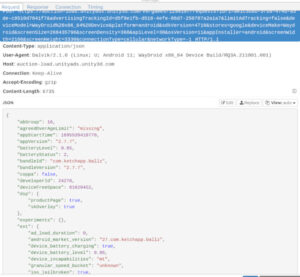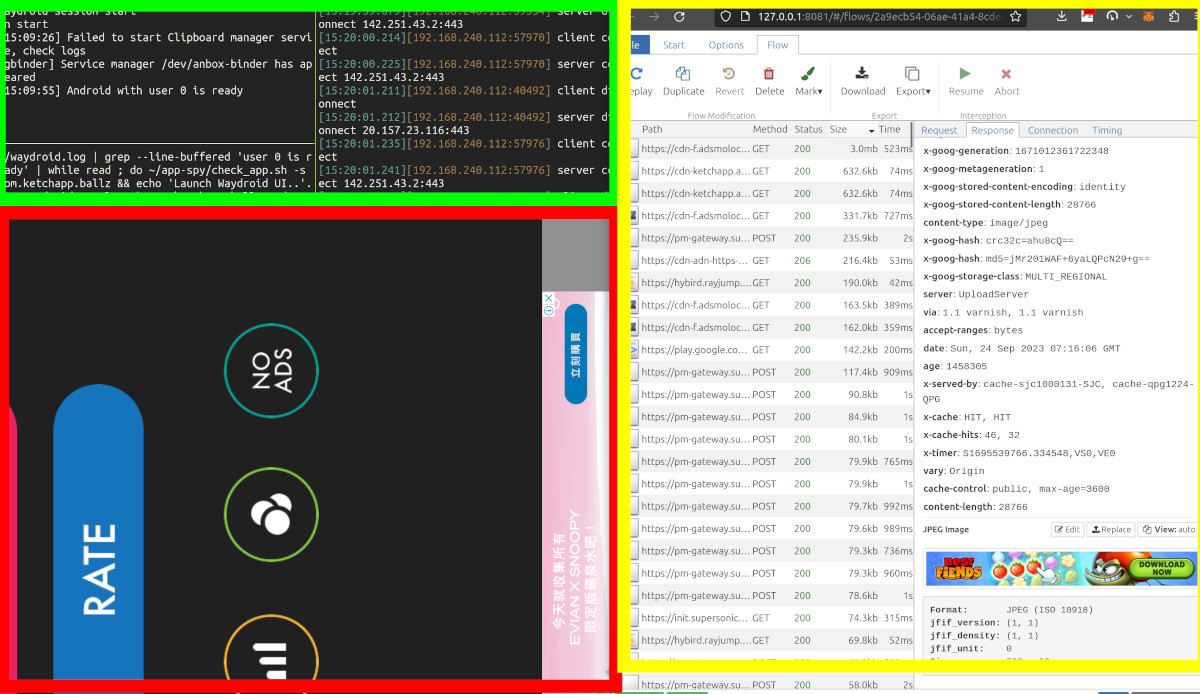NOTE: This is a snapshot of how I did this in early 2023. There may be a more up to date version on github for newer versions of Android:
https://github.com/ddxv/mobile-network-traffic/
How to Sniff Mobile HTTPs from Apps
These are my notes as I try to find a reliable way to collect HTTPS traffic from mobile apps on my phone or VM. Still have some questions as to which works best. This is all very much just a WIP / notes, but feel free to add or use. This took quite a bit of trial and error with a number of not working solutions, until I found this recent comment which worked perfect. Incase this helps anyone else I’m just writing my process here. Feel free to comment or let me know if you have other advice!
=====================
Waydroid VM & mitmproxy Setup Notes

Waydroid and mitmproxy are the two main tools you will use. Waydroid is an emulator for Android on Linux and will need a variety of custom software installed in it to make it work.
- Waydroid: Android Emulator for Linux
- Waydroid Transparent Proxy
- Waydroid Script Play services for using playstore and Google Play services
- currently having issues: Issue
Inital Waydroid & MITM Installation
- Waydroid Transparent Proxy
- Ensure iptables is working. I was able to solve this by explicitly add
/lib/x86_64-linux-gnu/xtablesto/etc/ld.so.conf.d/x86_64-linux-gnu.confand rebooting. This was reported working for Debian 11 and Ubuntu 20+ - Setup iptables. I put the necessary iptable additions into a script as I ran them quite often, and can sometimes pause your local or Waydroid connection and needed to be cleared after using. You can use this script or copy paste the code block below and adapt as needed.
- Run
./proxysetup.sh 8080 -wfor waydroid. Use-lif mitm for other device- NOTE:
proxysetup.shrunssudo iptables -t nat -Fat end to clear out iptables. This is because some of the iptable settings depending on proxy type can cause your connection to be blocked. But be warned, this will clear all custom iptables on your nat table you may have added.
- NOTE:
proxysetup.shruns the following commands, so feel free to run them yourself:```#!/bin/bash sudo iptables -t nat -A PREROUTING -i waydroid0 -p tcp --dport 80 -j REDIRECT --to-port $port sudo iptables -t nat -A PREROUTING -i waydroid0 -p tcp --dport 443 -j REDIRECT --to-port $port sudo ip6tables -t nat -A PREROUTING -i waydroid0 -p tcp --dport 80 -j REDIRECT --to-port $port sudo ip6tables -t nat -A PREROUTING -i waydroid0 -p tcp --dport 443 -j REDIRECT --to-port $port sudo sysctl -w net.ipv4.ip_forward=1 sudo sysctl -w net.ipv6.conf.all.forwarding=1 sudo sysctl -w net.ipv4.conf.all.send_redirects=0 mitmweb --mode transparent --showhost --set block_global=false ```- Start Waydroid service:
waydroid session start - Start Waydroid UI:
waydroid show-full-uiand check internet- Inside Waydroid, if internet can’t connect try
sudo waydroid shelland checkip linkandip addrto see if firewall blocking. More info at: ArchWiki Waydroid Networking - To install GApps I used CasualSnek’s Waydroid Script Installer
- Inside Waydroid, if internet can’t connect try
- Install certs (first time per device) in waydroid
- On target device, using a browser, navigate to
mitm.it - follow ALL instructions on mitm.it after downloading a cert file.
- NOTE: Firefox has SEPARTE certs from OS certs
- On target device, using a browser, navigate to
- In order to run two certificate tools (MagiskTrustUserCerts & SSLUnpinning) these framework tools installed into Waydroid
- Magisk Magisk is a suite of open source software for customizing Android, supporting devices higher than Android 5.0.
- To install in waydroid I used CasualSnek’s Waydroid Script Installer
- LSPosed Zygisk module trying to provide an ART hooking framework which delivers consistent APIs with the OG Xposed, leveraging LSPlant hooking framework. We will use this to install SSLUnpinning in a future step.
- Installation of this is quite easy, but has a few steps, I found this YouTube Video helpful to watch
- Magisk Magisk is a suite of open source software for customizing Android, supporting devices higher than Android 5.0.
- Finally, we can install our two custom tools into Magisk & LSPosed respectively:
- MagiskTrustUserCerts This Magisk module will take your user CA certs and move them to system or ‘root’ CA certifications which more apps will trust.
- SSLUnpinning This LSPosed module helps to unpin apps during runtime.
- Once everything is installed, shut down and open Waydroid and mitmproxy one more time. After this you should be able to see clear text HTTPS requests from your Waydroid VM.
========
Other Tools
Emulator vs Phone
This is the first question and probably the most dependent on what you want to achieve. Working on a real device gives more space between your device and the proxy which makes things easier. The extra space is costly in other ways. For example, I would prefer to have a single instance running on the computer to collect information, but using a phone is easier but has the physical requirement of a device connected to the network.
Phone
Physical separation allows for clearer testing. Fully functional device means your input and output work as expected.
Emulator – Waydroid
Emulator running on the same computer causes more complicated networking to ensure you don’t block your own traffic. Troubleshooting is trickier as it’s more difficult to easily access parts of the emulator that a phone is easy to access. For example, I spent much more time than I would have expected to move a VPN configuration file from my computer to the virtual machine emulator than I would have ever expected. Adding the same configuration to the phone was a simple QR code scan.
Emulator running in a virtual machine allows for a future use case of running the whole thing in the cloud without a physical device.
Proxies
As far as I know, the only way to capture the HTTPS traffic is to use a proxy. This is in the form of an application running on a separate (virtual or physical as mentioned above) device. The hardest part here is the Certificate Authority which signs the HTTPS traffic when it leaves the app. More sophisticated apps, to prevent fraud, do a variety of actions to prevent the user or 3rd parties from capturing the data in each HTTPS request.
mitmproxy
open source, link
I tried this first as it comes with Python library which would make capturing data for later analysis much easier. Mitmproxy has a few different modes, and ultimately I found that mitmproxy --mode wireguard which runs via VPN captured a good amount of traffic, but still had target SDK traffic unable to be opened. Mitmproxy has a built in tool to help installing the certificate in Android as a user certificate. This will capture some HTTPs traffic, but for some apps and many SDKs this does not capture their traffic. Traffic can be captured in several ways: CLI tool for analysis of live traffic in memory, CLI dump to file and in memory live in browser of choice.
Charles Proxy
free for 30 days, shareware, link
I first used Charles nearly 10 years ago, and it doesn’t feel like it’s changed much, but is actively maintained. When I first started using Charles it was a breeze to use, CA was less of a problem. But as Android changed it also now has the problems of CA needing to be installed, and helps the user by providing it’s own signed certificate which can be installed as a user certificate. Charles is a standalone program that you run and as such it does have a fair amount of issues on my linux environment related to it’s display sizes.
Burp Suite – Community Edition
paid/free, link
Community edition that is free to use. Runs in browser and comes with it’s own CA tool.
Android Certificate Authority
These are the certificates used to sign HTTPS traffic to keep it secure. In Android there are three levels: User, System (root) and App Pinned Certificates. In Android settings you can add a CA which will be considered “user”. Apps can choose whether to ignore this certificate. System CAs can only be set by a root user. While a user can install user CA’s, apps do not have to use these. CAs can be set by users as root certificates. I believe this must be set regardless of device or VM. The majority of the certificates provided by the proxies don’t seem to open a lot of HTTPS traffic. This is likely because Android N (API level 24) certificate pinning was introduced in 2016 and at this point most SDKs and Apps use this for transferring traffic.
JustTrustMe
open source, link
This is installed on a device or emulator. An Xposed addon that can be installed to force apps to use root authorities and prevent them from pinning their own CA.
apk-mitm
open source, link
This can be installed in a separate linux environment and is used to modify an app’s apk before being installed into a VM emultator or phone. It attempts to get around the app’s certificate pinning by patching the APK to disable certificate pinning.
Still can’t unpin? Frida and Objection
Blog for getting around Google pinning using pentesting tools
Objection

1 thought on “How to see traffic from your Android Device”
Comments are closed.